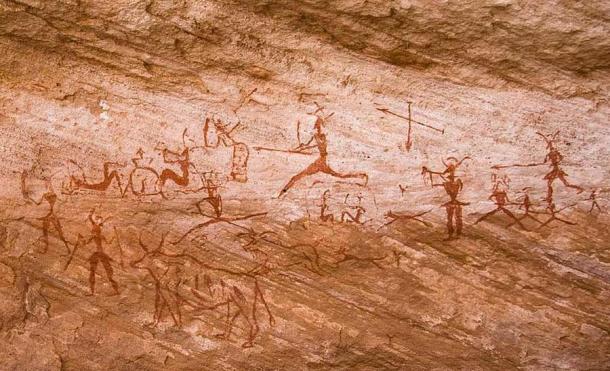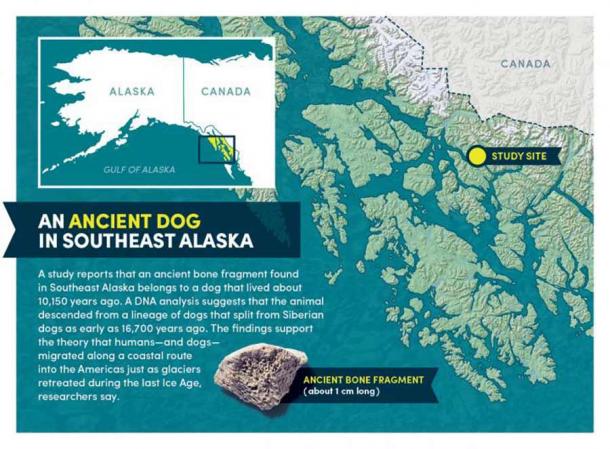Researchers have found the oldest known dog remains in the Americas and they believe the ancient dog bone fragment reveals how the canine and its brethren likely reached that part of the world.
How Man’s Best Friend Joined Us
Human and dog history has been linked for a very long time. Although the canine domestication date has been debated, there are suggestions that by 25 million years ago, a species called Cynodictis had evolved into African hunting dogs and Eurasian wolves and dogs. Before that, beginning about 45 million years ago, a large canine species known as Bear Dogs (amphicyonidae) may have shared the hunting lands of North America, Europe, Africa, and Asia with humans and the ancestors of domestic dogs ( Canis familiaris ), the Grey Wolf ( Canis lupus ).
After humans had domesticated dogs, it makes sense that they accompanied us across the world. But a team of researchers wanted to know how far back dog history goes in the Americas and the route the canines took to enter that part of the world.

Rock paintings in Tadrart Acacus region of Libya dated from 12,000 BC to 100 AD. (CC BY-SA 2.5 ) Human and dog history has been linked for a very long time.
The research team, led by the University at Buffalo and including scientists from the University of South Dakota as well, believes they have found the answers to those questions. This is all thanks to a 10,150-year-old dog bone fragment discovered in Alaska in 1998. At first, the researchers didn’t realize the significance of the discovery that was made among the more than 50,000 prehistoric human and animal remains found during the excavations near Wrangel Island.
They had a different interest in the bones at first, according to Charlotte Lindqvist, a biologist at the University at Buffalo and lead author of a new study published on the find in Proceedings of the Royal Society B. “This all started out with our interest in how Ice Age climatic changes impacted animals’ survival and movements in this region,” Lindqvist said. “We started out thinking this was just another bear bone.” But DNA analysis of the prehistoric bone fragment showed something far more interesting.
Discovering the Oldest Dog in the Americas
The small dog bone fragment comes from a femur and its age of 10,150-years-old makes it the oldest known dog in the Americas. Flavio Augusto da Silva Coelho, another of the paper’s authors and a PhD student in biological sciences at the University at Buffalo, says that “Before our study, the earliest ancient American dog bones that had their DNA sequenced were found in the U.S. Midwest. The fossil record of ancient dogs in the Americas is incomplete, so any new remains that are found provide important clues.”

This dog bone fragment, found in Southeast Alaska, belongs to a dog that lived about 10,150 years ago, a study concludes. Scientists say the remains, a piece of a femur, provide insight into the question of when dogs and humans first entered the Americas, and what route they took to get there. ( Douglas Levere / University at Buffalo )
And there were more clues to discover in the tiny dog bone chip. When the dog’s mitochondrial genome was compared to other ancient and modern dogs, the scientists discovered that it shared close genetic ties with the first known dogs – a species domesticated in what is now Siberia about 23,000 years ago. Further analysis shows the animal’s evolutionary line had diverged from Siberian dogs at least 16,700 years ago. That timeframe is significant because it overlaps with a period when scholars believe humans may have been migrating into North America along a coastal route.
While it used to be common belief that the first travelers into the Americas crossed over the Bering Strait on foot, more and more studies are questioning that idea. The emerging view now suggests that ancient maritime travelers set out from Beringia about 16,000 years ago, and within just 1500 years their followers had ended up all the way down the Pacific coast to modern day Chile.
How Does the Ancient Dog Bone Fragment Fit Into the Story?
The new study provides helpful clues into when and how dogs and humans migrated into the Americas and provides more support for the hypothesis that people moved into the Americas from Siberia along a coastal route that included the Alaskan archipelago about 16,000 years ago. According to Lindqvist, “Southeast Alaska might have served as an ice-free stopping point of sorts, and now — with our dog — we think that early human migration through the region might be much more important than some previously suspected.”
Lindqvist explains how the discovery of the dog bone fragment can further help with the debate on the peopling of the Americas:
“We now have genetic evidence from an ancient dog found along the Alaskan coast. Because dogs are a proxy for human occupation, our data help provide not only a timing but also a location for the entry of dogs and people into the Americas. Our study supports the theory that this migration occurred just as coastal glaciers retreated during the last Ice Age. There have been multiple waves of dogs migrating into the Americas, but one question has been, when did the first dogs arrive? And did they follow an interior ice-free corridor between the massive ice sheets that covered the North American continent, or was their first migration along the coast?”
Coelho states that “Our early dog from Southeast Alaska supports the hypothesis that the first dog and human migration occurred through the Northwest Pacific coastal route instead of the central continental corridor, which is thought to have become viable only about 13,000 years ago.”

The ancient dog bone fragment and a map of the study area. ( Bob Wilder / University at Buffalo )
The presence of chemical isotopes showing the dog ate marine animals further supports the idea that dogs and humans were moving together into the region along a coastal route. Since dogs are not generally recognized for having good fishing skills, it’s likely that humans fed them scraps of fish, seal, or perhaps whale.
The new paper ‘An early dog from southeast Alaska supports a coastal route for the first dog migration into the Americas’ is published in Proceedings of the Royal Society B.
Top Image: Flavio Augusto da Silva Coelho, a University at Buffalo PhD student in biological sciences, holds the ancient dog bone fragment that was found in Southeast Alaska. Scientists believe it holds clues to the peopling of the Americas. Source: Douglas Levere / University at Buffalo
By Alicia McDermott
Related posts:
Views: 0
 RSS Feed
RSS Feed

















 February 27th, 2021
February 27th, 2021  Awake Goy
Awake Goy 




 Posted in
Posted in  Tags:
Tags: 
















